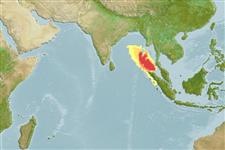>
Anguilliformes (Eels and morays) >
Congridae (Conger and garden eels) > Congrinae
Etymology: Bathycongrus: Greek, bathys = deep + Latin, conger = conger (Ref. 45335).
More on author: Alcock.
Environment: milieu / climate zone / Tiefenbereich / distribution range
Ökologie
seewasser bathydemersal. Deep-water
Eastern Indian Ocean: Andaman Islands.
Size / Gewicht / Alter
Geschlechtsreife: Lm ? range ? - ? cm
Kurzbeschreibung
Bestimmungsschlüssel | Morphologie | Morphometrie
Origin of dorsal fin above front margin of pectoral base. Vomerine teeth small with 2-4 slightly enlarged. Vomerine patch oval, almost circular, reaching opposite from of second IO pore.
Body shape (shape guide): eel-like.
Life cycle and mating behavior
Geschlechtsreife | Fortpflanzung | Ablaichen | Eier | Fecundity | Larven
Ben-Tuvia, A., 1993. A review of the Indo-west Pacific congrid fishes of genera Rhynchoconger and Bathycongrus with the description of three new species. Isr.l J. Zool. 39:349-370. (Ref. 7446)
IUCN Rote Liste Status (Ref. 130435: Version 2025-1)
Bedrohung für Menschen
Harmless
Nutzung durch Menschen
Tools
Zusatzinformationen
Download XML
Internet Quellen
Estimates based on models
Phylogenetic diversity index (Ref.
82804): PD
50 = 0.5000 [Uniqueness, from 0.5 = low to 2.0 = high].
Bayesian length-weight: a=0.00063 (0.00029 - 0.00138), b=3.18 (3.00 - 3.36), in cm total length, based on LWR estimates for this (Sub)family-body shape (Ref.
93245).
Trophic level (Ref.
69278): 3.8 ±0.5 se; based on size and trophs of closest relatives
Widerstandsfähigkeit (Ref.
120179): mittel, Verdopplung der Population dauert 1,4 - 4,4 Jahre. (Preliminary K or Fecundity.).
Fishing Vulnerability (Ref.
59153): Low to moderate vulnerability (29 of 100).
🛈
